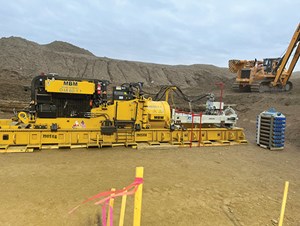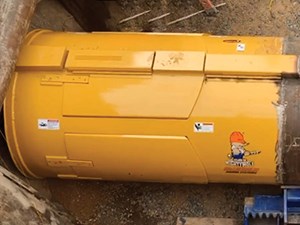August 2022 Vol. 77 No. 8
Features
Modern Guidance for Auger Boring Matches Growth of Technology
Jeff Griffin | Senior Editor
Horizontal auger boring equipment was making trenchless installation beneath roads, highways and other obstacles for years before the term “trenchless technology” came into use.
Early auger bores were unguided. Because they were relatively short, they didn’t have much length to wander from their path, as long as soil conditions were suited for boring. However, as longer bores became more practical and appropriate, it was obvious that a method to maintain the proper line and grade of the insulation was needed.
Today, the use of guided auger bores is increasing. Underground Construction asked leading manufacturers to explain how their guidance system operate and have addressed the requirements of longer bores, sometimes in difficult soil conditions.
MV Solutions
Vermeer MV Solutions Business Development Manager Dave Gasmovic said auger boring is one of the oldest forms of trenchless technology for underground utility installation work. But initially, the machines lacked the ability to accurately make steering adjustments while in the ground.
Guided auger boring solutions to address this were developed in the 1980s, expanding the capabilities of auger boring machines.
“The use of auger boring, in general,” he continued, “is growing as municipalities upgrade their storm drainage infrastructure, sewer systems and water lines. In many cases, they turn to auger boring because it’s less invasive than excavating, and the machines can install casing ranging from 20 to 72 inches in diameter and up to 600 feet in length. “
Together, these factors have made it necessary to use guidance systems, Gasmovic believes.
First, the amount of existing infrastructure has increased. Also, there is a tendency to set manholes before the boring process. Casing must be installed at a certain grade and online. The demand for greater distances also has increased the need for accuracy to reduce auger friction and allow longer bores to be made.
Any time that a pipe needs to maintain a specific grade or line, a guidance system should be used on auger boring projects. The most common products that require lines and grade to be maintained are gravity sewer and storm sewer systems. But many contractors will employ guidance systems anytime they are boring 100 feet or more, because being slightly off at the start of a bore can have major implications at longer distances.
Gasmovic said the McLaughlin On-Target Steering (OTS) system has grown in popularity. It can be paired with any brand of auger boring machine to help maintain line and grade. Bores can be made in a single pass using an auger boring machine and OTS system; using a pilot tube system requires multiple passes.
“With the OTS system,” he said, “the auger boring machine is placed in the entry pit, and a control station is put next to it. A steerable cutting system, matching the size of the casing being installed, is then welded to the first casing, and the first auger section is bolted to the steerable head’s cutter.
“Four hydraulic lines are then connected from each steering flap on the steerable head to the control station. These lines are connected to the top of the steerable head, and a cover helps protect the connections. A water line is run from the control station’s recirculation tank to the steerable head for real-time accurate grade reading. An optional electrical pitch indicator can also be used in conjunction with the water level indicator.”
The water line is checked through the casing opening using two LED lights mounted inside the steerable head. Course corrections are made from the control station by hydraulically extending or retracting the steerable head’s flaps.
To steer up, the operator needs to open the flap on the bottom. He or she can steer down by extending the top flap, steer to the right by extending the left side flap, and steer to the left by opening the right flap. There is no need to pull augers to make course corrections. All adjustments can be made in real-time while installing the finished casing.
Once the bore is completed, the steerable head is removed on the exit pit side, and a clean-out bit is attached to the end of the auger string to remove any debris from the inside of the casing.
Gasmovic said control stations of the OTS system are equipped with a 50-gallon water tank and a 6,500 psi hydraulic pump. The system is effective in dirt, clay, sand, shale and rock less than 8,000 psi, and varying conditions mixed with cobble.
Akkerman
Guided auger boring is probably the most popular trenchless method of construction, said Jason Holden, vice president and chief revenue officer for Akkerman. Technology for exact line and grade trenchless installations is gaining more acceptance in the trenchless community. There are many new innovations with guided boring technology that allow longer distances, more geotechnical conditions, and broader range of installation techniques.
“There are several situations that are conducive to guided auger boring,” he said. “I know of several contractors that utilize guided auger boring on every auger bore situation, whether it requires it or not. Pilot tube guides provide pin-point accuracy, which allows a smaller casing to be used since it will be on-line and grade, and there are other useful benefits.”
For example, he said auger boring projects generally do not have extensive geotechnical investigations, as they are quite costly. The installation of a pilot tube will not only give a contractor an indication of the ground type on the project, but will also provide a definitive answer, if there is an obstruction along the alignment.
Since the pilot tubes can be removed and the ground will go back to the native state, the position of the obstruction can be identified and mitigated before it is too late.
“Our GBM guidance system,” continued Holden, “utilizes a theodolite and LED target type system. It requires a line-of-sight from the launch shaft all the way to the steering head, where an LED target is located. In common terms, the guidance system acts much like common surveying technology.
“A powerful camera with remote controls is used to communicate with proprietary software that allows the operator to view the position of the steering head.”
Alternative systems, such as sonde locators, he added, are also an option for some projects that do not require exact line and grade. These systems can be used in conjunction with the standard GBM guidance systems.
Holden said the installation of pilot tubes is intended for straight line installs.
“The maximum degree of directional change is dependent upon the allowable accuracy on the project,” he explained. “The overall accuracy of the installation will be dependent upon the accuracy of the equipment set-up, which is highly dependent on the initial site survey.”
Akkerman Model 240A GBM, Holden said, can be used with any manufacturer’s auger boring system. It is a universal base frame that offers adjustability for various rail widths and centerline heights.
“We have found that this base accommodates most ABM from 36 to 72 inches. Akkerman also offers a stand-alone power pack to operate the GBM system so the contractor can utilize one GBM system with multiple ABM systems in the fleet.”
Often referred to as “leap-frogging,” contractors will install pilot tubes on one project and then move the GBM system to another site to work ahead while their ABM installs casing on the initial site.
Technology advances
Holden said as technology advances, so do guidance systems.
“We always keep up with the latest technology advancements on our guided boring systems,” he said. “We also strive to allow legacy systems to be easily updated to current levels so customers can operate at peak performance.”
Akkerman offers various package upgrades for specific projects requiring advanced data logging and smart LED targets with temperature sensing.
“Michael Byrne Manufacturing has worked with Akkerman to produce a line of auger boring machines that are hydraulically ready to operate an Akkerman 240A GBM system,” Holden said.
“These units can directly couple their Akkerman 240A GBM system to a MBM auger boring machine to perform at optimal levels for an additional external power pack.”
Holden added that an additional system, such as high-pressure lubrication, and advanced pilot-tube-to-casing connections such as the GRS-50 swivel and RBU series, are growing the market.
Guided pneumatic hammer technology is being used more frequently and will be an emerging trend as more options become available, he pointed out.
American Augers
American Augers Product Manager Richard Levings said guided auger boring projects are increasing and there are multiple reasons.
“On-line-and-grade installations, precise tie-in points, presence of critical utilities and structures, easement restrictions, and project owner requirements are among the reasons,” Levings said. UC
FOR MORE INFORMATION:
Vermeer MV Solutions (McLaughlin), (864) 277-5870, mclaughlinunderground.com
Akkerman Inc., (800) 533-0386, akkerman.com
American Augers, (800) 324-4930, americanaugers.com






Comments